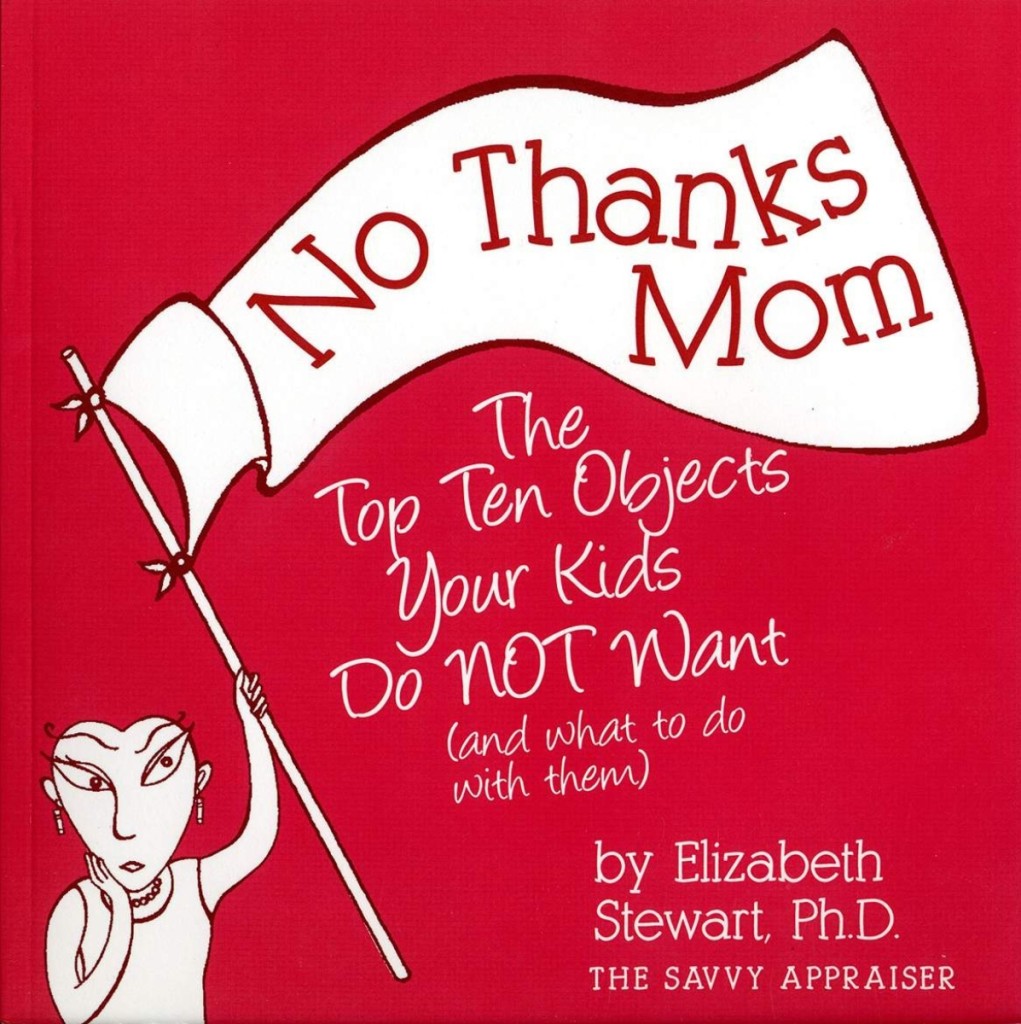Elizabeth Stewart, PhD, describes herself as a “30-year ‘stuff’ veteran” in the appraisal business on two coasts (offices in Santa Barbara and Atlanta). She is a certified member of the Appraisers Association of America, analyzing art and antiques for estate planning to let her clients know the best places to sell their “stuff” or why certain things are worth keeping. Her new book, No Thanks Mom: The Top Ten Objects Your Kids Do NOT Want (and what to do with them) should be on every Baby Boomer parent’s bookshelf.
You have some personal experience in your book subject area; what happened?
My son, who was attending Duke, and his future wife after announcing their engagement found a house near Durham that they liked and planned to fix up. I started collecting things in one of those large pods, such as a quality dinner service, a good set of silver, maybe a nice rug, those sorts of things. Then I went maybe a little overboard, thinking about things that they would probably never buy themselves – a set of Thanksgiving china and what about Spode Christmas china? … And it went on and on. All these things were shipped from California to North Carolina, but I never heard a word from my son and his fiancé. Finally, one day my daughter-in-law called and said, “We’re taking the house, c’mon over.” So coming from California to North Carolina, I just had my jeans clothes and because it was around Thanksgiving, we got an invitation to a high-end friend’s house for dinner. I didn’t have a dress to wear and, lo and behold, when I went to the local Goodwill to look for one, I saw that’s where most of the stuff I had sent them had ended up.
What did you say?
I said absolutely nothing.
Good move. What trends do you draw from this?
First, the value and significance of certain types of objects has changed in the past 30 years. What has value to older generations – those over 50 – and younger under-50 children is significantly different. Second, those relegated objects symbolize that change in the meaning of value, especially with regard to what makes a comfortable home. Value has a greater meaning today and is often gauged by ease of life, adaptability, status, utility, functionality and short-term pleasure. You and I may have been eager to receive our grandmothers’ fine crystal, but our kids dread the day.
So no “heirlooms”?
Millennials and Gen-Xers also acquire objects, they just aren’t the traditional heirlooms. I think the main difference, boiling it down, and falling in step with the “experience” aesthetic of the younger generations, is that for the Silent generation and the Boomer generation, value is intrinsic – take a gold-rimmed china service for 24, for example. For the Gen-Xers and Millennials, value is extrinsic – value is not in the object but the experiential offerings of that object. Take the constantly updated smartphones, for example. Value is the potential of what the object can offer, not the ritual or narration it itself contains and symbolizes.
Without giving too much away from your book, what is number 10?
Books. Unless your grown kids are professors, they don’t want your books. In terms of valuing them, they are a very special valuation object and it takes a real expert to know the great ones. First editions, of course, are valuable, and even more so if signed by the author.
What’s the most interesting boomer versus Millennial dynamic?
Myopia. We assume a civilized home will be a certain way. Dinner parties, for example, were once conducted with a formal china service. A junior bank executive’s wife might have a small tea service, a supper service and one formal dinner service – and certain patterns were considered appropriate for one’s income level and the time of day one dined. For Millennials in general a dinner party is organized around an event. The emphasis is on grabbing something quick, sometimes around a barroom table with their posse of friends.
Sounds like they are not as materialistic as their parents.
Yes, but, ironically, Millennials at $2.5 trillion are the greatest spending group. What they spend more than 75 percent of their money on, however, is the “experience” – technology, apparel and brands. It represents a sea change and reversal in amassing exterior trappings. And that’s not to say that material culture is dead. It’s not and never will be. We’re just seeing the material culture timeline shrink before our eyes. The Victorian era might have lasted 100 years, but today 20-30 years is considered ancient history.
Any general advice on what to do with those family treasures and lifetime collections that may have passed through generations?
If you want to give appreciated gifts of objects from your home, plan your downsizing in advance. And get your offspring involved via the technology they use daily – photos, videos and emails with bullet-pointed lists. No surprise packages. Give your kids a requested timeline for a decision.
-W.A. Demers





